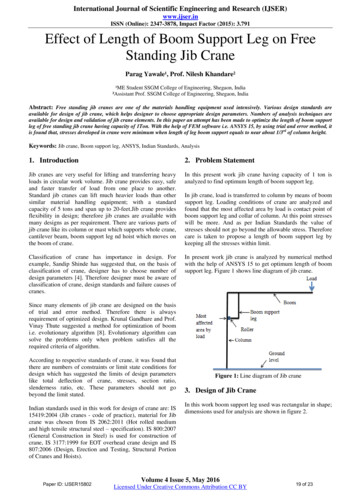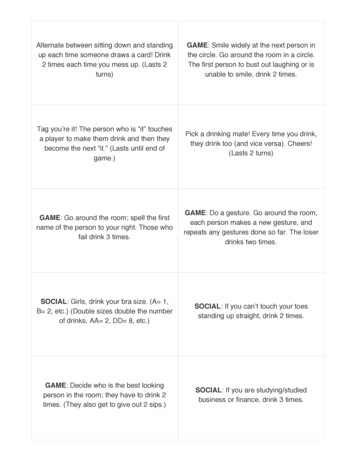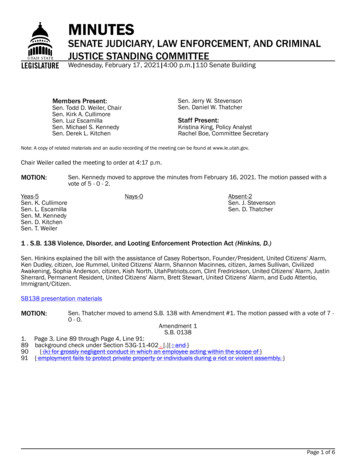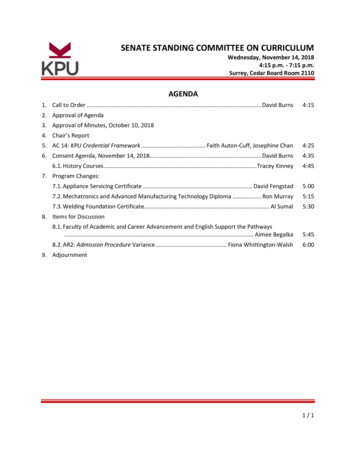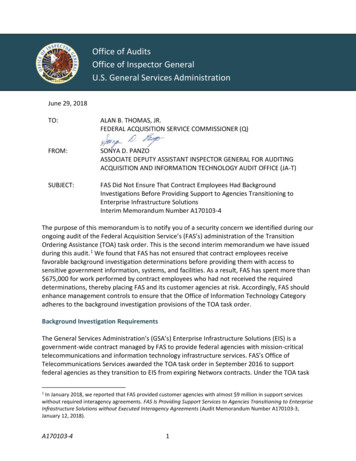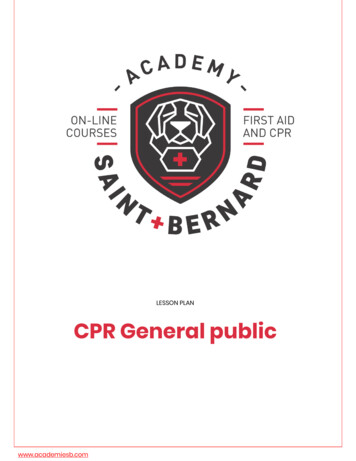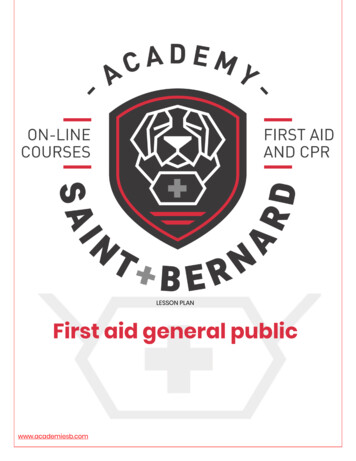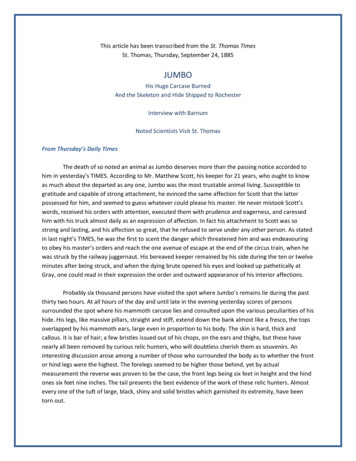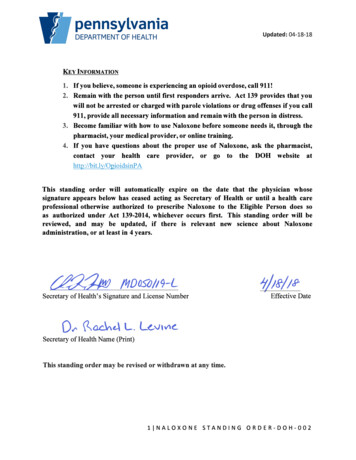
Transcription
Updated: 04-18-18KEY INFORMATION1. If you believe, someone is experiencing an opioid overdose, call 911 !2. Remain with the person until first responders arrive. Act 139 provides that youwill not be arrested or charged with parole violations or drug offenses if you call911, provide all necessary information and remain with the person in distress.3. Become familiar with how to use Naloxone before someone needs it, through thepharmacist, your medical provider, or online training.4. If you have questions about the proper use of Naloxone, ask the pharmacist,contact your health care provider, or go to the DOH website athttp://bit.Iy/OpioidsinPAThis standing order will automatically expire on the date that the physician whosesignature appears below has ceased acting as Secretary of Health or until a health careprofessional otherwise authorized to prescribe Naloxone to the Eligible Person does soas authorized under Act 139-2014, whichever occurs first. This standing order will bereviewed, and may be updated, if there is relevant new science about Naloxoneadministration, or at least in 4 years. /11DOS0/19-LSecretary of Health's Signature and License NumberEffective DateSecretary of Health Name (Print)This standing order may be revised or withdrawn at any time.llNALOXONE STANDING ORDER-DOH-002
STANDING ORDER DOH-002-2018Naloxone Prescription for Overdose PreventionNaloxone Hydrochloride (Naloxone) is a medication indicated for reversal ofopioid overdose inthe event ofa drug overdose that is the result ofconsumption or use ofone or more opioid-relateddrugs causing a drug overdose event.I.PURPOSEThis standing order is intended to ensure that residents of the Commonwealth of Pennsylvaniawho are at risk ofexperiencing an opioid-related overdose, or who are family members, friends orother persons who are in a position to assist a person at risk of experiencing an opioid-relatedoverdose (Eligible Persons), are able to obtain Naloxone. This order is not intended to beused by organizations who employ or contract with medical staff who are authorized to writeprescriptions. Such organizations should utilize the medical professionals with whom they have arelationship to write prescriptions specific to personnel who would be expected to administerN aloxone, and would be wise to ensure that all such personnel are appropriately trained in theadministration of Naloxone.II.AUTHORITYThis standing order is issued pursuant to Act 139 of 2014 (Act 139) (amending The ControlledSubstance, Drug, Device and Cosmetic Act (35 P.S. §§ 780-101 et seq.)), which permits healthcare professionals otherwise authorized to prescribe Naloxone to prescribe it via standing order toEligible Persons.III.AUTHORIZATIONThis standing order may be used by Eligible Persons as a prescription or third-partyprescription to obtain Naloxone from a pharmacy in the event that they are unable toobtain Naloxone or a prescription for Naloxone from their regular health care providers oranother source. This order is authorization for pharmacists to dispense Naloxone anddevices for its administration SOLELY in the forms prescribed herein.IV.TRAINING AND INSTRUCTIONAL MATERIALSPrior to obtaining Naloxone under this standing order, Eligible Persons are strongly advised tocomplete a training program approved by the Pennsylvania Department of Health (DOH) inconsultation with the Pennsylvania Department of Drug and Alcohol Programs (DDAP), such asthe one found on line at www.getnaloxonenow.org or at the DOH websiteat http://bit.ly/NaloxoneinP A and obtain a certificate of completion. Act 139 does notrequire training; however, training is necessary in order to ensure that Eligible Persons areprotected from legal liability to the extent that Act 139 provides that the receipt ofDOH/DDAP-approved training2IDOH NALOXONE STANDING ORDER-DOH-002c
and instructional materials and prompt seeking of additional medical assistance creates a rebuttablepresumption that an Eligible Person acted with reasonable care in administering Naloxone.V.SIGNS AND SYMPTOMS OF OPIOID OVERDOSE1. A history of current narcotic or opioid use or fentanyl patches on skin or needle in the body.2. Unresponsive or unconscious individuals.3. Not breathing or slow/shallow respirations4. Snoring or gurgling sounds (due to partial upper airway obstruction).5. Blue lips and/or nail beds.6. Pinpoint pupils.7. Clammy skin.8. Note that individuals in cardiac arrest from all causes share many symptoms with someonewith a narcotic overdose (unresponsiveness, not breathing, snoring/gurgling sounds, and blueskin/nail beds). If no pulse, these individuals are in cardiac arrest and require CPR.VI.APPROPRIATE USE AND DIRECTIONSEligible Persons should be aware of the following information when dealing with a person who itis suspected is experiencing an opioid overdose event:1. Call 911 for EMS to be dispatched.2. In cardiac arrest or pulseless patients: Call 911 for EMS and start CPR if able and trained todo so. In cardiac arrest, CPR is the most important treatment, and any attempt to administerNaloxone should not interrupt chest compressions and rescue breathing.3. Naloxone should only be given to someone suspected of opioid overdose as noted in the signsand symptoms listed in Section V above.4. In respiratory arrest or a non-breathing patient: If able to do rescue breathing, rescue breathingtakes priority over Naloxone administration. Administer Naloxone if possible while doingrescue breathing.5. Administration of Naloxone (only give to someone with suspected opioid overdose based onsigns and symptoms listed in Section V above).3IDOH NALOXONE STANDING ORDER-DOH-002c
A. INTRA-NASAL NAL0X0NEEligible Persons should be provided with the following:1. Luer-lock syringes and mucosal atomization devices (MAD)a. Two 2 mL Luer-Jet luer-lock syringes prefilled with naloxone (concentration 1mg/mL);b. Two mucosal atomization devicesc. Patient informationinstructions.pamphletcontainingdosage andadministration2. NARCAN Nasal Spraya. Carton containing two blister packages each with single 4 mg dose of naloxonein a 0.1 mL intranasal sprayb. Package insert containing dosage and administration instructions.Instructions for use:1. Luer-lock syringes and mucosal atomization devices (MAD)a. Pop off two yellow caps from the delivery syringe and one red cap from thenaloxone vial.b. Screw the Naloxone vial gently into the delivery syringe.c. Screw the mucosal atomizer device onto the top of the syringe.d. Spray half (1ml) of the Naloxone in one nostril and the other half (1ml) in theother nostril.e. Note: Administer the Naloxone in a quick burst to ensure that it is atomized. Aslow administration will cause liquid to trickle in without being atomizedproperly, which will slow delivery to the bloodstream.f. Continue to monitor breathing and pulse. IF NOT BREATHING, ive rescuebreathing. IF NO PULSE, start CPR, if able and trained to do so.g. If patient does not awaken after 4 minutes, administer second dose ofNaloxone(if available) (lmL) briskly in one nostril and the other half (lmL) briskly inthe other nostril.4jDOH NALOXONE STANDING ORDER-DOH-002c
h. Remain with the person, monitor breathing/pulse, and provide rescue breathingor provide CPR ifneeded, until he or she is under care ofa medical professional,such as a physician, nurse, or EMS.2. NARCAN Nasal Spraya. Lay person on their back to receive a dose ofNARCAN Nasal Spray.b. Remove NARCAN from the box. Peel back the tab with the circle to open theNARCAN Nasal Spray.c. Hold the NARCAN Nasal Spray with your thumb on the bottom ofthe plungerand first and middle fingers on either side ofthe nozzle.d. Tilt the person's head back and provide support under the neck with your hand.Gently insert tip of nozzle into one nostril until fingers on either side ofthenozzle are against the bottom ofthe person's nose.e. Press the plunger firmly to give the dose ofNARCAN Nasal Spray.f. Remove the NARCAN Nasal Spray from the nostril after giving the dose.g. Move the person onto their side after giving NARCAN Nasal Spray.h. Remain with the person, monitor breathing/pulse. IF NOT BREATHING,give rescue breathing. IF NO PULSE, start CPR, if able and trained to doso.1.Remain with the person, monitor breathing/pulse, and provide rescue breathingor provide CPR ifneeded, until he or she is under care ofa medical professional,such as a physician, nurse, or EMS.J. Watch the person closely. Ifthe person does not respond by waking up, to voiceor touch, or breathing normally another dose may be given. NARCAN NasalSpray may be dosed every 2 to 3 minutes, if available, until the personresponds or emergency medical help is received.B.INTRA-MUSCULAR NALOXONE, BYWAY OF AUTO-INJECTOREligible Persons should be provided with the following:1. Two EVZIO (naloxone hydrochloride injection, USP) 0.4 mg auto-injectors or two2.0 mg auto-injectors2. A single Trainer for EVZIO3. Patient instructionsSIDOH NALOXONE STANDING ORDER-DOH-002c
Instructions for use:1. Currently the only available auto injector comes with automated voice instructions(EVZIO ) and has a speaker that provides voice instructions to help guide youthrough each step of the injection.a. Follow automated voice instructions.2. If the auto-injection device does not come with automated voice instruction or theautomated voice instruction is otherwise disabled, follow below. The auto-injectiondevice should still work even if the automated voice instructions do not.a. Prepare device1.For EVZIO 1. Pull off the Red safety guard. Note: The Red safety guard ismade to fit tightly. Pull firmly to remove. To reduce thechance of an accidental injection, do not touch the Blackbase of the auto-injector, which is where the needle comesout.b. Hold injector with a fisted hand if possible and press firmly against outerthigh, until you hear a click or hiss. EVZIO can be used through clothing.One auto injector delivers 0.4 mg or 2.0 mg naloxone.c. Continue to hold pressure for a full 10 seconds to ensure full delivery ofmedication. Note: The needle will inject and then retract back up into theEVZIO auto-injector and is not visible after use. Do not look for theneedle as this will put you at risk for needle stick injury.d. Continue to monitor breathing and pulse. If not breathing, give rescuebreathing. If no pulse, start CPR.e. If no response in 3-5 minutes, repeat the above instruction with a new auto injection device.f. Remain with the person, monitor and support breathing until he or she isunder the care of a medical professional, such as a physician, nurse, or EMS.C.REFILLSRefills may be obtained as needed under this standing order.GIDOH NALOXONE STANDING ORDER-DOH-002c
VII.CONTRADICTIONSDo not administer Naloxone to a person with known hypersensitivity to Naloxone or toany ofthe other ingredients contained in the packaging insert for Naloxone.VIII.PRECAUTIONSA. DRUG DEPENDENCEThose who may be chronically taking opioids are more likely to experience adversereactions from Naloxone. (See adverse reactions under section X below). Additionally,after administration, they may awaken disoriented. Being disoriented can sometimeslead to combative behavior, especially ifNaloxone is given by someone unfamiliar.B.RESPIRATORY DEPRESSION DUE TO OTHER DRUGSNaloxone is not effective against respiratory depression due to non-opioid drugs.Initiate rescue breathing or CPR as indicated and contact 911.C. PAIN CRISISIn patients taking an opioid medication for a painful illness such as cancer,administration ofNaloxone can cause a pain crisis, which is an intense increase in theexperience of pain as the Naloxone neutralizes the pain-relieving effect of the opioidmedication. Comfort the patient as much as possible and contact 911 as the patientmay need advanced medical treatment to ease the pain crisis.IX.USE IN PREGNANCY (Teratogenic Effects: Pregnancy Category C)Based on animal studies, no definitive evidence of b irth defects in pregnant or nursingwomen exists to date. There also have not b een adequate studies in humans to make adetermination.X.ADVERSE REACTIONSA. OPIOID DEPRESSIONAb rupt reversal of opioid depression may result in nausea, vom1tmg, sweating,ab normal heart b eats, fluid development in the lungs and opioid acute withdrawalsyndrome (see part B b elow), increased b lood pressure, shaking, shivering, seizuresand hot flashes.B.OPIOID DEPENDENCEAbrupt reversal of opioid effects in persons who are physically dependent on opioidsmay cause an acute withdrawal syndrome.Acute withdrawal syndrome may include, but not be limited to, the following signs andsymptoms: b ody aches, fever, sweating, runny nose, sneezing, yawning, weakness,7jDOH NALOXONE STANDING ORDER-DOH-002c
shivering or t rembling, nervousness, or irrit abilit y, diarrhea, nausea or vomiting,abdominal cramps, increased blood pressure, and fast heart beats.Most often the symptoms of opioid depression and acute withdrawal syndrome areuncomfortable, but sometimes can be severe enough to require advancedmedical attention.BIDOH NALOXONE STANDING ORDER-DOH-002c
Two EVZIO (naloxone hydrochloride injection, USP) 0.4 mg auto-injectors or two 2.0mg auto-injectors 2. A single Trainer for EVZIO 3. Patient instructions SIDOHNALOXONE STANDING ORDER-DOH-002c . the through Ins
